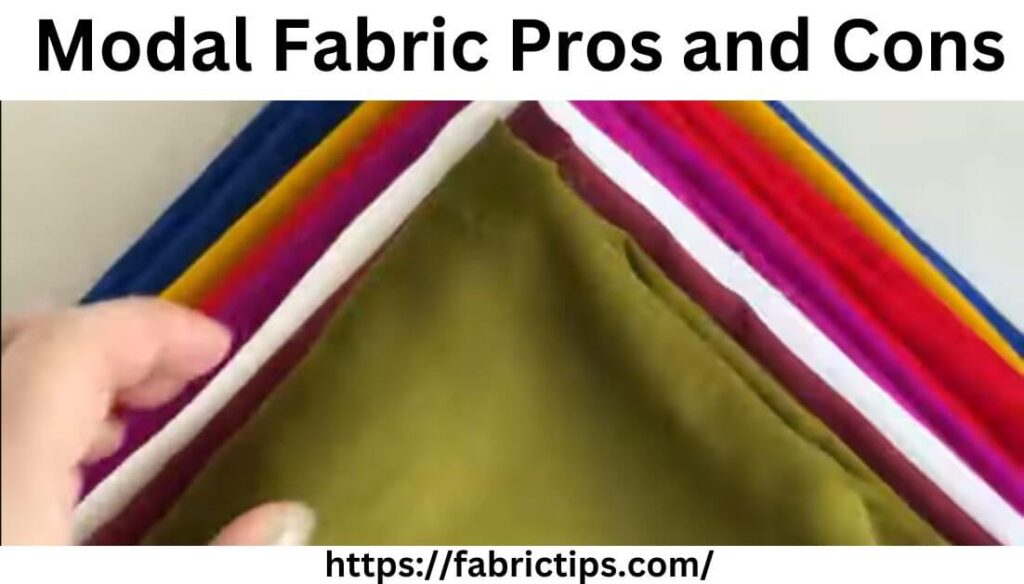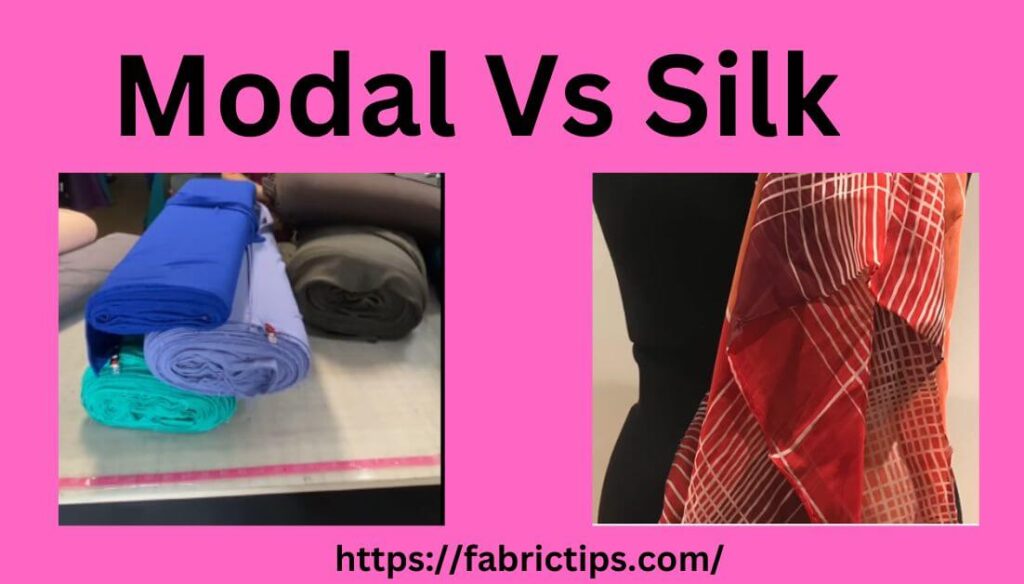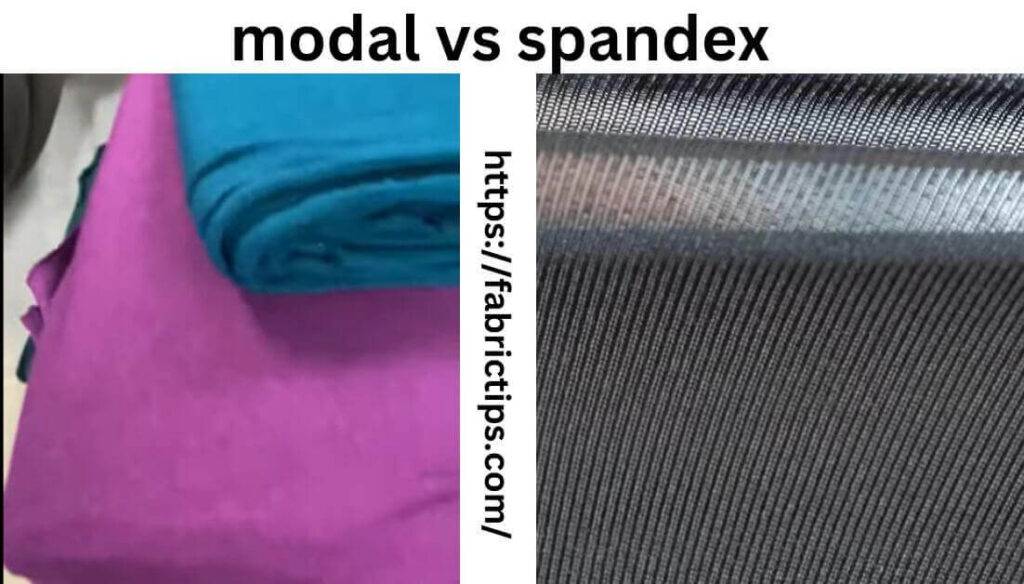Last Updated on December 20, 2022 by Wahid
“Modal fabric” is becoming increasingly popular in the fashion industry. Pajamas and underwear are primarily made of this semi-synthetic fabric. However, it can also be used for household products such as towels and bedsheets.
Modal is always the perfect fabric. The product is technically a type of rayon, a plant-based alternative, more flexible and durable than standard rayon. While modal is an eco-friendly alternative to cotton and viscose, its sustainability level is controversial. Due to its thinness, softness, and breathability, Modal is widely used in sportswear as like yoga pants, bike shorts, and swimwear.
Although the modal fabric has higher durability than rayon, it cannot be denied that it’s softer. In this article, we provide a guideline for the modal fabric pros and cons. Well, let’s begin.
Modal Fabrics: What Are They?
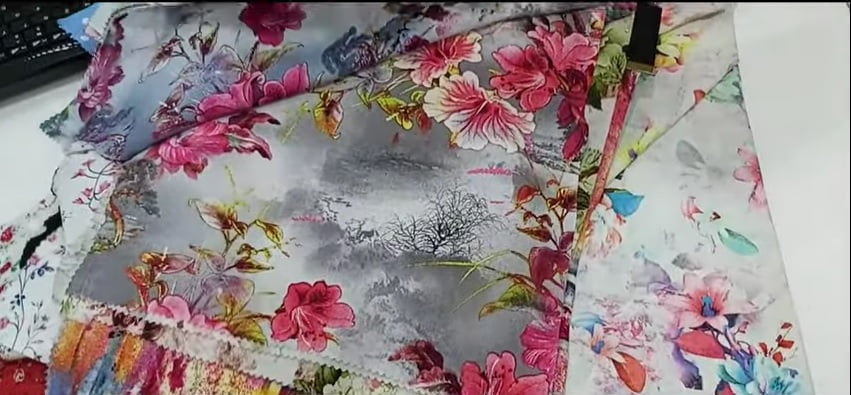
- In textiles, modal is a semi synthetic and bio-based product produced from “beech tree pulp.”
- Modal is a rayon product from cellulose, an upgraded viscose rayon version.
- It is a high-modulus rayon and will become stronger after getting wet.
- Its high durability, high breathability, and environmental friendliness make it superior to viscose.
- Thus, modal materials offer many advantages over viscose fabrics.
- This fabric’s softness and breathability make it ideal for activewear, pajamas, and undergarments.
- It is also commonly used for bath towels and bed sheets.
Modal Fabric: How Is It Manufactured?
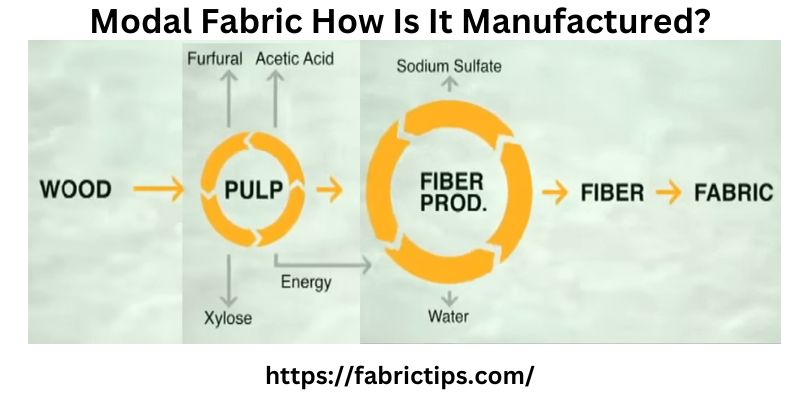
- Fabrics made from modal are more eco-friendly than fabrics made from viscose rayon.
- Modal is part of the rayon family; therefore, it has similar production requirements to viscose rayon.
- Using pre-reconstituted beech trees, fibers are spun from cellulose3, and the industry produces cellulose fiber by manufacturing it.
- The manufacturing process for modal fabrics begins with beech tree harvesting.
- This process involves chipping trees down & extracting cellulose from them. As a result, cellulose sheets are formed.
- Then, sodium hydroxide is applied to the sheets. As a result, crumbs created from these sheets are soaked in carbon dioxide.
Modal Fibers: Semi-Synthetic
- The strength of modal fibers is enhanced by blending them with synthetic and organic materials.
- Even though it is made from plants, textiles must be soaked in chemicals in order to be valuable.
- In comparison to cotton & viscose, this material costs more and is considered luxurious.
Modal Fabrics: A History
- A modal fabric traced back to 1951 in Japan. In 2nd-generation regenerated cellulosic fibers, modal is made from pulp from beech trees. In order to replace silk fabric, manufacturers developed it.
- Following this, Lenzing AG began selling its own brand in 1964. Currently, the company specializes in manufacturing modals.
- In 1977, “Lenzing AG” introduced a green bleaching process for its cellulosic fibers2. Lenzing Modal is the trademark for the fabric company’s own modal.
- Modal fabric is also known by the brand names “Formatex” and “China Modal.” Nevertheless, Lenzing Modal adheres to strict environmental guidelines.
Modal Fabrics: How Sustainable Are They
- It is often questioned whether the modal fabric is eco-friendly and sustainable, but it is worth investigating.
- Upon examination, despite coming from plants, this fabric is still processed with chemicals & dyes.
- Another challenge is destroying forests, particularly when companies fail to involve sustainable forests in their production processes.
- Questions arise about the sustainability of modal fabric & how it impacts the environment.
Modular Fabric’s Sustainability Varies Depending On Its Manufacturing Process
- Generally, the level of eco-friendliness of modal varies with the company & its processes. Factors like chemical types, pulp source, and how wastewater is treated can be considered during manufacturing.
- For example, modal fabric requires approximately 10-20 times as little water than cotton. Compared to cotton plants, beech trees require less water. Therefore, cotton has a smaller carbon footprint than hemp.
- Studies found that spinning-dyed modal fabrics are 60% more efficient and use 50% less energy in their production from cradle to gate. In addition, it uses 50% less water than traditionally dyed fabrics. As a result, it has a 40-60% less environmental impact than similar fabrics1.
- 2012 saw the launch of a variant of “Lenzing Modal” to demonstrate its commitment. Earlier this year, the company released Modal Color. With this variation, the dyeing process is eco-friendly, unlike that of other semi-synthetic fabrics. The process of making rayon is also becoming more conscious of other manufacturers.
Modal Fabric Pros And Cons: Details Discussions
You might want to consider adding this fabric to your wardrobe options, then take a look at these modal fabric benefits and drawbacks.
Pros Of Modal
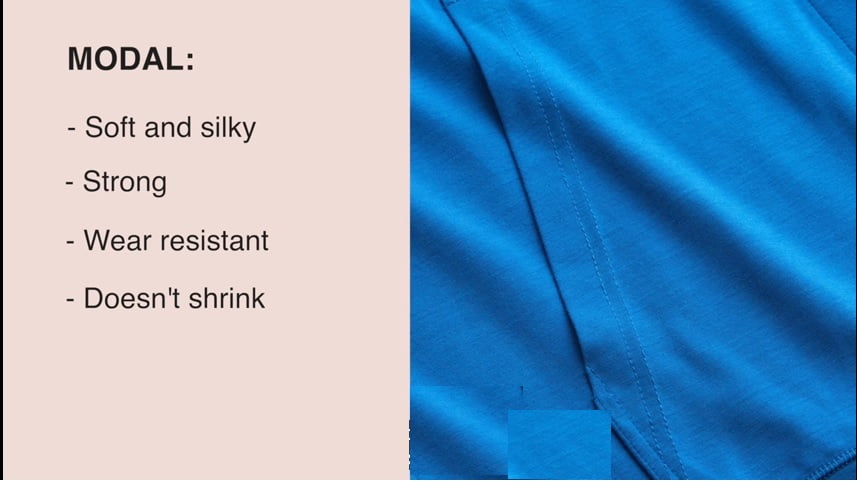
Water-Absorbent
Fabrics made of Modal absorb water. Thus, it is an excellent material for activewear & underwear. Furthermore, this quality allows the modal fabric to absorb dye & ensures that the garment will stay colorfast after washing.
The Softest Touch
In addition to being soft to the touch, modal fabric has many desirable properties. As a result, modal clothing feels soft against the skin.
Eco-Friendly
Fabrics made from rayon fibers such as viscose and Modal are eco-friendly alternatives. Since it is made from regenerative plants, it uses fewer chemicals. During the process of extracting cellulose fibers, fewer toxic wastes are produced.
Biodegradable
The fabric of Modal is biodegradable. Thus, it can decompose without polluting landfills.
Shrinkage Is Less Likely
Fabrics made from modal shrink less when washed than fabrics made from viscose rayon. It keeps its shape even when washed in a machine.
Stretchy And Breathable Fabric
Modal fabric is a great deal of breathability and stretch. Sporting clothes and everyday clothing can both benefit from these properties.
Pill-Resistant & Durable
Modal fabric is strong, resistant to piling, and withstands wear & pressure. In addition to being pill-resistant, rayon also has a smooth texture. In other words, the modal fabric is wrinkle-resistant and smooth.
Cons Of Modal
Harmful Chemicals
A carbon disulfide solution is applied to cellulose to produce modal fabric. The compound carbon disulfide is neurotoxic. By blowing into the air, it is released into the environment, causing health problems. During the rayon production process, factories also produce contaminated water.
Forest Destruction
Unless it comes from Lenzing, modal clothes are typically not made with renewable forest pulp.
Allergic Reaction
First-time wearers of modal fabric may experience an allergic reaction. There have been reports of rashes, itching, & redness associated with the use of this textile.
Modal Fabric: The Best Way To Take Care Of
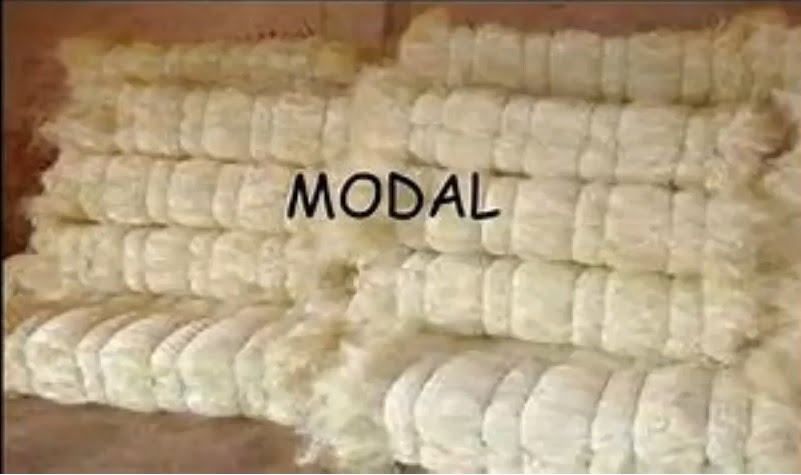
It is vital that modal clothes are properly cared for. In this way, the items will have a longer life cycle. Your pieces can be cared for in the following ways:
Water Temperature
Pure modal clothes can be washed at a variety of temperatures on the washing machine. Nevertheless, using cold water is the best & most sustainable option. As a result, shrinkage is prevented.
Keep Delicates In Wash Bags
Whenever you machine-wash delicate items like underwear and lingerie, use a wash bag. The products are thus protected in this way.
Drying
In spite of air drying being ideal, a low- to the medium-heat dryer can also be used.
Oxygen-Based Bleach
Modal fabric can be weakened by chlorine bleach. The best bleach to use for your clothes is oxygen-based bleach.
Modal Vs Cotton

There are a number of clothing brands now that use modal in some of their products instead of cotton. Textiles are often combined with this fabric in a garment, depending on how it will be used.
- Cotton/modal blends are used to create clothing for a variety of activities and uses. In contrast to cotton, modal dries faster and is more absorbent.
- In addition, it won’t stick to your skin when it’s wet. Its sustainability in clothing makes it a popular fabric for sportswear and activewear, incorporating other fibers as well.
- This eco-friendly material replaces cotton with Lenzing Modal. Producing cotton consumes a great deal of water.
- One kilogram of cotton requires 22,500 liters of water to be produced in India. Yet, during the production of the modal, less water is used.
- As a result, it is more eco-friendly compared to cotton. Cotton is cheaper than modal textiles, however.
Modal Vs Lyocell

- The “TENCEL Lyocell” fabric is more eco-friendly as compared to the modal fabric.
- The reason for this is that modal rayon is created by using organic solutions.
- In comparison to sodium hydroxide, which is used by many manufacturers to make modal, lyocell is significantly less toxic.
- The modal is derived from beech trees, as we’ve already established.
- Conversely, eucalyptus and beech trees both produce lyocell.
Modal Vs Viscose
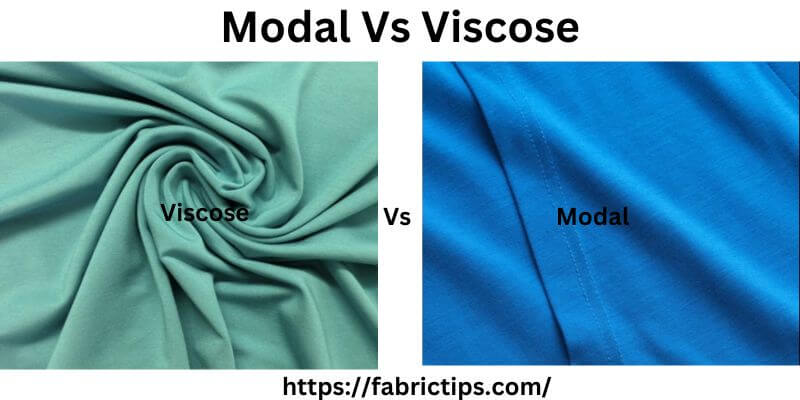
- Even though viscose & modal are produced with similar methods, they differ in many ways.
- The durability and strength of the modal fabric are greater than those of viscose rayon.
- However, this does not prevent it from being breathable and lightweight.
- In order to make modular products, fewer chemicals are required.
- Because of this, the modal fabric is less hazardous than viscose rayon.
- In particular, TENCEL Modal is sourced through sustainable forests.
- Modal is, therefore, a better choice than viscose rayon for this reason.
FAQs
01. Is modal fabric good for hot weather?
Modal is a semi-synthetic “cellulose fiber,” classed as a rayon fiber. Due to its 50% greater absorbency than cotton, Modal keeps you feeling fresh and cool by wicking moisture away from your body. Modal is a perfect fabric for warmer weather due to its smoothness and softness.
02. What is better, cotton or modal?
Since modal has a finer knit than cotton, it’s generally considered more durable. Modal fabric tends to be stronger & more durable than cotton. When washed repeatedly, cotton doesn’t pile up as well as stays stable.
03. Does modal shrink in the dryer?
Despite its similarities to cotton and rayon, a modal will not shrink nearly the same as cotton. Modal shrinks primarily as a result of high-heat dryer cycles. Shrinkage is caused by plant fibers shriveling up when heated.
04. Is modal better than polyester?
“Sustainability.” Known as the biodegradable “synthetic,” Modal has become one of the most widely used alternatives. Despite being softer, smoother, durable, and more absorbent than polyester, it’s not completely natural. Even with the numerous chemicals required for its production, polyester is an eco-friendly & sustainable alternative.
05. Does modal stretch or shrink?
While rayon shrinks or stretches when wet, modal fabric remains shaped after washing and drying. There is a 50% difference in shrinkage resistance between cotton and linen, which has stronger fibers and less friction on the surface.
06. Which is better, viscose or modal?
Modal is more flexible and durable than viscose, and its fiber strength is higher when wet. Due to the fibers’ ability to keep their shape, it’s easier to wash.
07. Can you machine wash modal fabric?
Typically, rayon fabrics made from beech fibers are called Modal. Instead of shrinking or stretching like other rayon fabrics, modal clothing retains its shape easily and can be machine washed and dried.
08. Can you iron the modal fabric?
In woven fabrics containing silk, wool, or modal fibers, you can iron the fabric. The material can be burned at very high temperatures. To prevent the fabric from burning, use a pressing cloth. It is always best to iron fabrics from the inside out.
09. Is modal fabric quick drying?
Because they are comfortable, soft, lightweight, and look like silk, Modal fabrics feel like luxurious silk. The feel of Modal fibers is very pleasant. In addition to being water-absorbent, they dry quickly as well.
10. Is modal better than bamboo?
Compared to bamboo, Modal breathes better. Compared to bamboo, it is more breathable & moisture-wicking, despite being more absorbent when compared to cotton.
11. Is modal toxic?
Sodium hydroxide, carbon disulfide, and sulfuric acid are among the toxic chemicals used in modular. By manufacturing modal without a closed-loop system, air or water can be contaminated with this neurotoxin.
In Conclusion
This concludes our discussion of modal fabric pros and cons. Whenever you choose a fabric, you should consider the manufacturer’s transparency. Modal fabrics are produced in a variety of facilities.
Obviously, plant-based materials are environmentally friendly. However, not all adhere to high environmental standards during the production process.
Generally, the quality and sustainability of the fibers used in the creation of modal fabric, and in particular TENCEL Modal, is undeniable. Thus, modal fabrics encompass a variety of what makes them sustainable materials.
